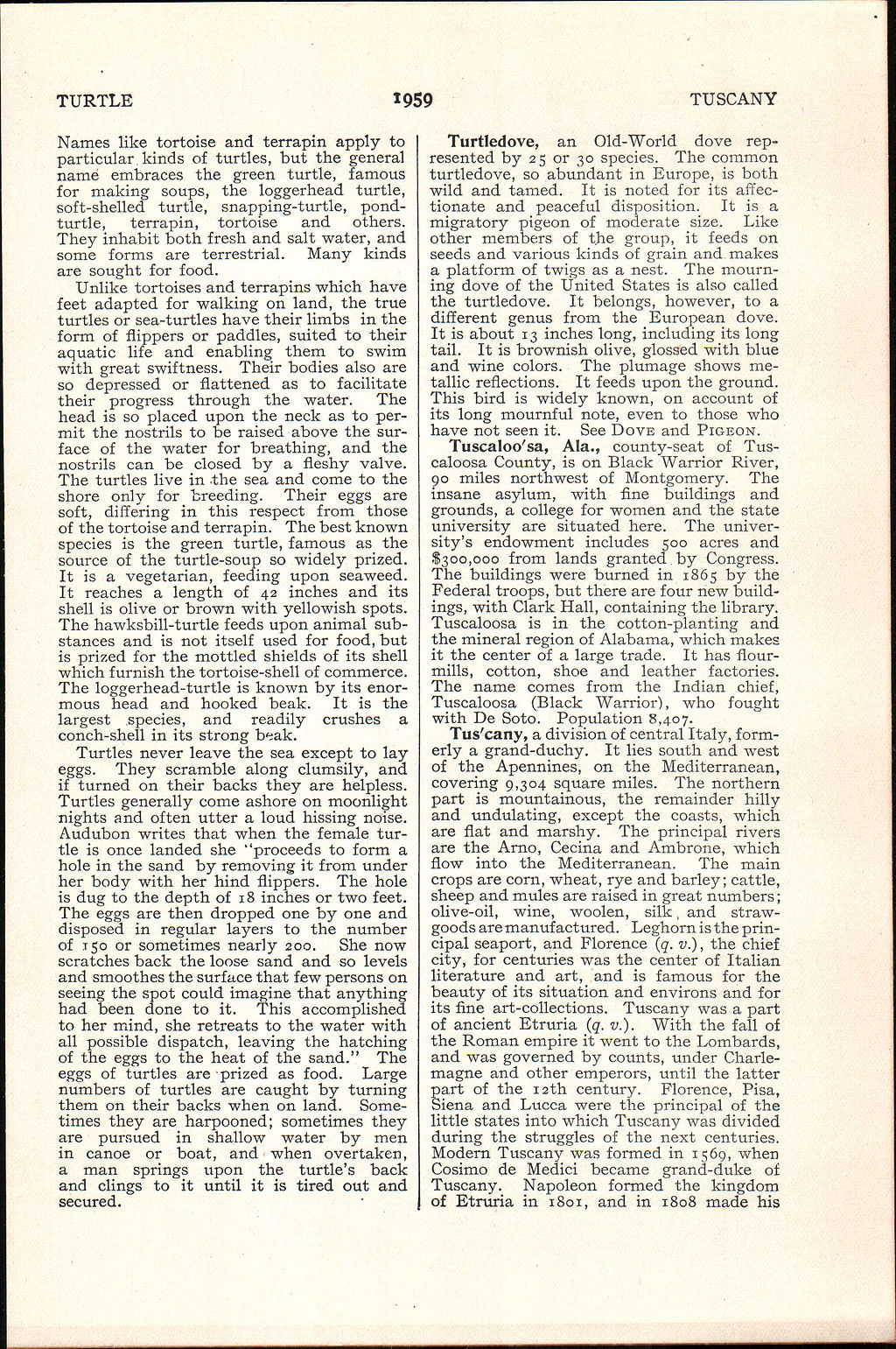TURTLE
- 959
TUSCANY
Names like tortoise and terrapin apply to particular kinds of turtles, but the general name embraces the green turtle, famous for making soups, the loggerhead turtle, soft-shelled turtle, snapping-turtle, pond-turtle, terrapin, tortoise and others. They inhabit both fresh and salt water, and some forms are terrestrial. Many kinds are sought for food.
Unlike tortoises and terrapins which have feet adapted for walking on land, the true turtles or sea-turtles have their limbs in the form of flippers or paddles, suited to their aquatic life and enabling them to swim with great swiftness. Their bodies also are so depressed or flattened as to facilitate their progress through the water. The head is so placed upon the neck as to permit the nostrils to be raised above the surface of the water for breathing, and the nostrils can be closed by a fleshy valve. The turtles live in -the sea and come to the shore only for breeding. Their eggs are soft, differing in this respect from those of the tortoise and terrapin. The best known species is the green turtle, famous as the source of the turtle-soup so widely prized. It is a vegetarian, feeding upon seaweed. It reaches a length of 42 inches and its shell is olive or brown with yellowish spots. The hawksbill-turtle feeds upon animal substances and is not itself used for food, but is prized for the mottled shields of its shell which furnish the tortoise-shell of commerce. The loggerhead-turtle is known by its enormous head and hooked beak. It is the largest species, and readily crushes a conch-shell in its strong beak.
Turtles never leave the sea except to lay eggs. They scramble along clumsily, and if turned on their backs they are helpless. Turtles generally come ashore on moonlight nights and often utter a loud hissing noise. Audubon writes that when the female turtle is once landed she "proceeds to form a hole in the sand by removing it from under her body with her hind flippers. The hole is dug to the depth of 18 inches or two feet. The eggs are then dropped one by one and disposed in regular layers to the number of .150 or sometimes nearly 200. She now scratches back the loose sand and so levels and smoothes the surface that few persons on seeing the spot could imagine that anything had been done to it. This accomplished to her mind, she retreats to the water with all possible dispatch, leaving the hatching of the eggs to the heat of the sand." The eggs of turtles are prized as food. Large numbers of turtles are caught by turning them on their backs when on land. Sometimes they are harpooned; sometimes they are pursued in shallow water by men in canoe or boat, and when overtaken, a man springs upon the turtle's back and clings to it until it is tired out and secured.
Turtledove, an Old-World dove represented by 25 or 30 species. The common turtledove, so abundant in Europe, is both wild and tamed. It is noted for its affectionate and peaceful disposition. It is a migratory pigeon of moderate size. Like other members of the group, it feeds on seeds and various kinds of grain and. makes a platform of twigs as a nest. The mourning dove of the United States is also called the turtledove. It belongs, however, to a different genus from the European dove. It is about 13 inches long, including its long tail. It is brownish olive, glossed with blue and wine colors. The plumage shows metallic reflections. It feeds upon the ground. This bird is widely known, on account of its long mournful note, even to those who have not seen it. See DOVE and PIGEON.
Tuscaloo'sa, Ala., county-seat of Tus-caloosa County, is on Black Warrior River, 90 miles northwest of Montgomery. The insane asylum, with fine buildings and grounds, a college for women and the state university are situated here. The university's endowment includes 500 acres and $300,000 from lands granted by Congress. The buildings were burned in 1865 by the Federal troops, but there are four new buildings, with Clark Hall, containing the library. Tuscaloosa is in the cotton-planting and the mineral region of Alabama, which makes it the center of a large trade. It has flour-mills, cotton, shoe and leather factories. The name comes from the Indian chief, Tuscaloosa (Black Warrior), who fought with De Soto. Population 8,407.
Tus'cany, a division of central Italy, formerly a grand-duchy. It lies south and west of the Apennines, on the Mediterranean, covering 9,304 square miles. The northern part is mountainous, the remainder hilly and undulating, except the coasts, which are flat and marshy. The principal rivers are the Arno, Cecina and Ambrone, which flow into the Mediterranean. The main crops are corn, wheat, rye and barley; cattle, sheep and mules are raised in great numbers; olive-oil, wine, woolen, silk, and straw-goods are manufactured. Leghorn is the principal seaport, and Florence (q. v.)t the chief city, for centuries was the center of Italian literature and art, and is famous for the beauty of its situation and environs and for its fine art-collections. Tuscany was a part of ancient Etruria (q. v.). With the fall of the Roman empire it went to the Lombards, and was governed by counts, under Charlemagne and other emperors, until the latter part of the i2th century. Florence, Pisa, Siena and Lucca were the principal of the little states into which Tuscany was divided during the struggles of the next centuries. Modern Tuscany was formed in 1569, when Cosimo de Medici became grand-duke of Tuscany. Napoleon formed the kingdom of Etruria in 1801, and in 1808 made his
